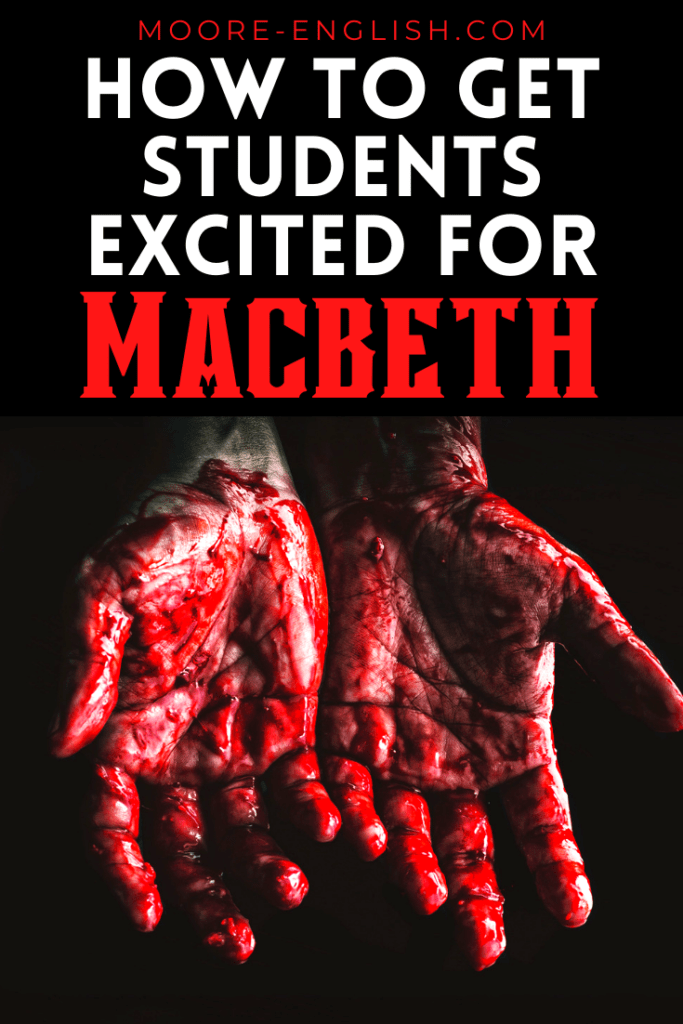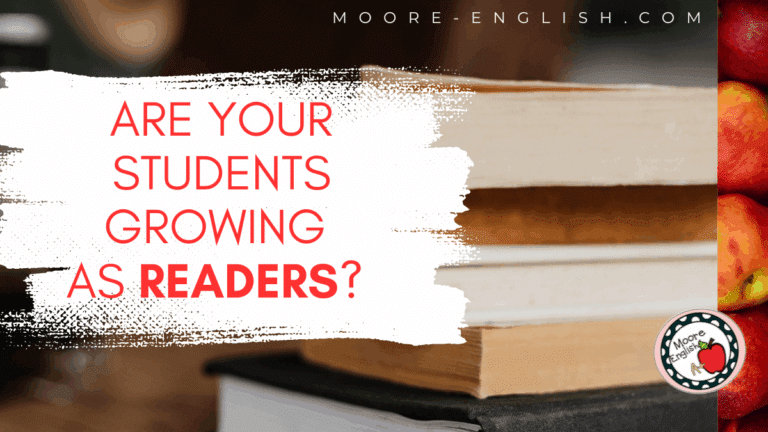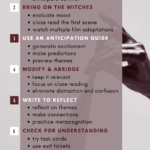Macbeth was the first Shakespeare play I ever taught, and it helped me appreciate how much fun your students can have while acting out a drama in the classroom! Here are some of my favorite activities and lessons to use with William Shakespeare’s Macbeth.
This post this post may contain affiliate links. Please read the Terms of Use.
Getting Started with Macbeth
As with any unit, getting students excited is essential! Sometimes students have previous experiences with Shakespeare or expectations about how boring Shakespeare can be. For this reason, I always try to engage my students with enthusiasm. Here are some of my favorite ways to engage students in Macbeth:
Firstly, we begin by making a cast “family tree.” This helps students begin to see the connections between characters. As we build our cast anchor chart, I give students a little preview of how the character acts and behaves. Plus, this generates excitement!
Secondly, I bring in the witches. The Weird Sisters are some of the most memorable characters in Macbeth, so they are a great opportunity for engaging students. We begin by close reading the first scene and then watching several film adaptations. Students can analyze how different directors’ choices affect the mood, and they can begin making predictions about the play. Here are some excellent versions of the play:
- Macbeth (2015) directed by Justin Kurzel and starring Michael Fassbender.
- Macbeth (2011) directed by Rupert Goold and starring Patrick Stewart.
- The Royal Shakespeare Company does Macbeth (2018) directed by Polly Findlay and Robin Lough.
- Macbeth (1979) directed by Philip Casson and starring Ian McKellan and Judi Dench.
Thirdly, I use this free anticipation guide. This activity helps students begin making connections to the text, activate prior knowledge, and engage in conversation. Depending on the group of students I have, this resource can be part of station rotation or part of a classroom discussion.
While Reading Macbeth

During our reading and acting of Macbeth, I use this modified and abridged version of the text. While Macbeth is a short play, I often find myself wanting to abbreviate or eliminate some scenes and adjust some vocabulary (the Porter, anyone?). For this reason, I designed this modified and abridged resource with the text on one side and guided reading questions on the other.
Throughout our reading, I encourage students to make connections with the text through the use of journals. By writing about the play, students have an opportunity to see how the text remains relevant. This also allows me to check for understanding, preview themes, and keep students writing regularly even in a reading-heavy unit.
Task cards are another great way to check for understanding throughout the play. While journals are usually bell ringers during this unit, task cards can be exit tickets or parts of station rotations. I choose the task cards based on the skills my students most need to work on. Here are some of my favorite task card sets:
- Characterization Task Cards
- Plot and Conflict Task Cards
- Figurative Language Task Cards
- All of these task cards (and more) are included in my ELA Task Cards Bundle!
Additionally, it’s important for students to discuss the text throughout our reading. During discussion, students can evaluate Macbeth’s character development, Lady Macbeth’s influence, and the dangers of ambition and revenge. Similarly, discussions can also re-visit the ideas featured in the anticipation guide, giving us time to re-evaluate how or if our opinions have changed. Depending on my group of students or the time of the year, silent discussions can be a good way to go!
My favorite!
Finally, my favorite part of reading Macbeth is the banquet. I start talking about the banquet in the first act. As we get closer to the banquet scene, my students plan their own banquet. We push our desks into a long banquet table, in non-pandemic years everyone brings in food, and we feast while Banquo haunts Macbeth! It’s a fun way to emphasize the climax of the play! (Plus, my students love food days!)
Macbeth Essential Questions
During our reading, students and I stay focused on essential questions. While we’re reading, these essential questions can become journal prompts, questions for discussion, or the basis for a larger writing or project.
- Firstly, is ambition dangerous?
- Secondly, is fear a good motivator?
- Is weakness an innate part of humanity?
- What does it mean to be a strong leader?
- Are leaders born or made? How do you know?
- Does free will exist, or does each person have a destiny?
- Finally, what are the elements of a successful relationship?
Synthesizing Macbeth
Throughout our reading of Macbeth, we emphasize synthesizing. Students can synthesize the intersection of Macbeth with its historical contexts. Did Shakespeare include witches because King James I was interested in witchcraft? Was he honoring the king by including his potential ancestor Banquo?
In addition, I often encourage students to synthesize across media. To do so, we might return to film versions of the play. However, I often prefer to use artwork for this pursuit. To make this activity successful, I have put together 23 images of different scenes from the play, including multiple portrayals of the Weird Sisters and of Lady Macbeth. As with the film clips of the opening scene, analyzing different pieces of art provides students with a chance to evaluate how artists use shade, lighting, and composition to create mood.
Similarly, as we near the end of the text, I also incorporate paired passages. This allows students to synthesize across texts, evaluating how different authors comment on similar subjects. Here are some paired passages that work with Macbeth:
- Firstly, “I, being born a woman and distressed” by Edna St. Vincent Millay provides an interesting view on womanhood. Since Macbeth comments on gender roles, this poem is a great opportunity. Read it here.
- Secondly, “Miniver Cheevy” by Edwin Arlington Robinson features a protagonist obsessed with what he can never have. Unlike Macbeth, Miniver does not resort to violence to achieve his goals. However, like Miniver, Macbeth is obsessive. Read it here.
- Thirdly, Shakespeare’s sonnets are a good complement to any of his plays. This post describes an inquiry-based approach to teaching Shakespeare’s sonnets. In particular, I often show the Crash Course about Shakespeare’s sonnets and give students an opportunity to write their own.
Extending and Assessing
One of the great things about teaching Macbeth is the opportunity to continue the learning beyond the play. While I don’t give a traditional test about the play, I do usually show the Crash Course episode about Macbeth as a review at the end of the play and as a lead-in to summative discussion.
Finally, Macbeth lends itself so well to applying literary criticism! In particular, Lady Macbeth makes a great opportunity for feminist criticism. Similarly, Macbeth suits archetypal criticism well because he is such a clear tragic hero. The imbalances in the play and the violence also make it a candidate for psychoanalytical criticism.
What other strategies do you use to get students excited for reading Macbeth?


Photo by Bogdan Kupriets, Valentin Salja, and Yevhen Ptashnyk on Unsplash



















